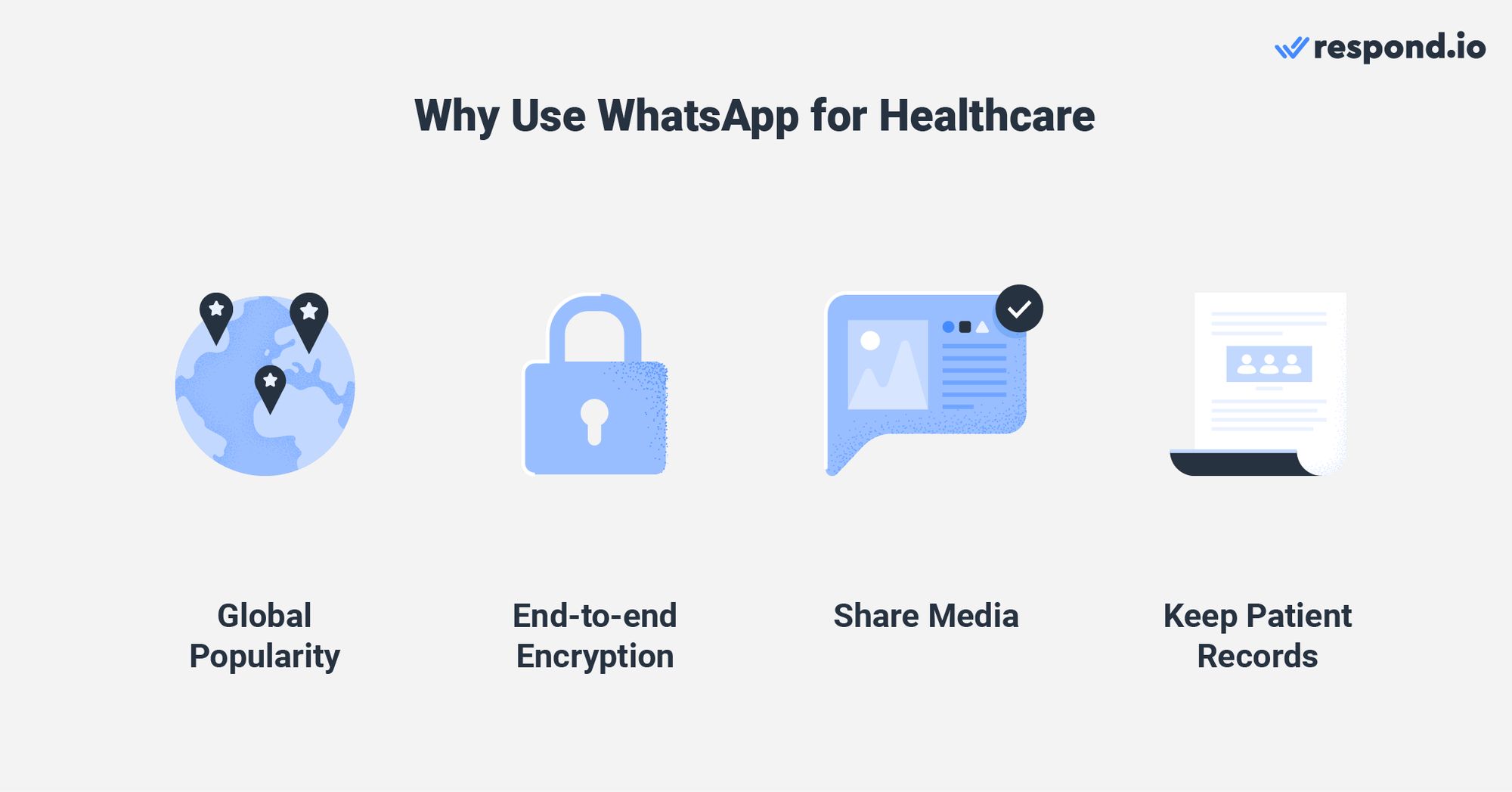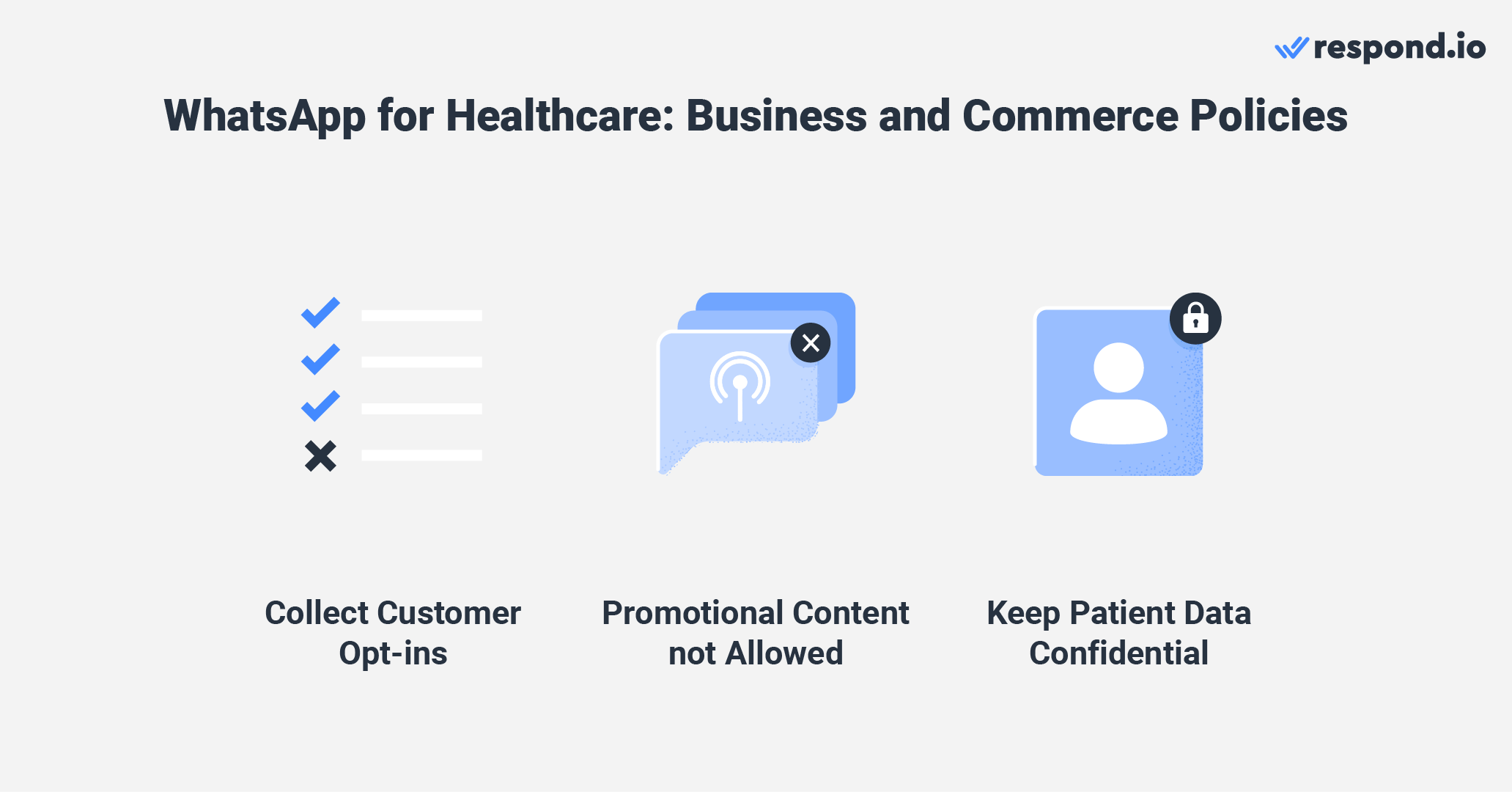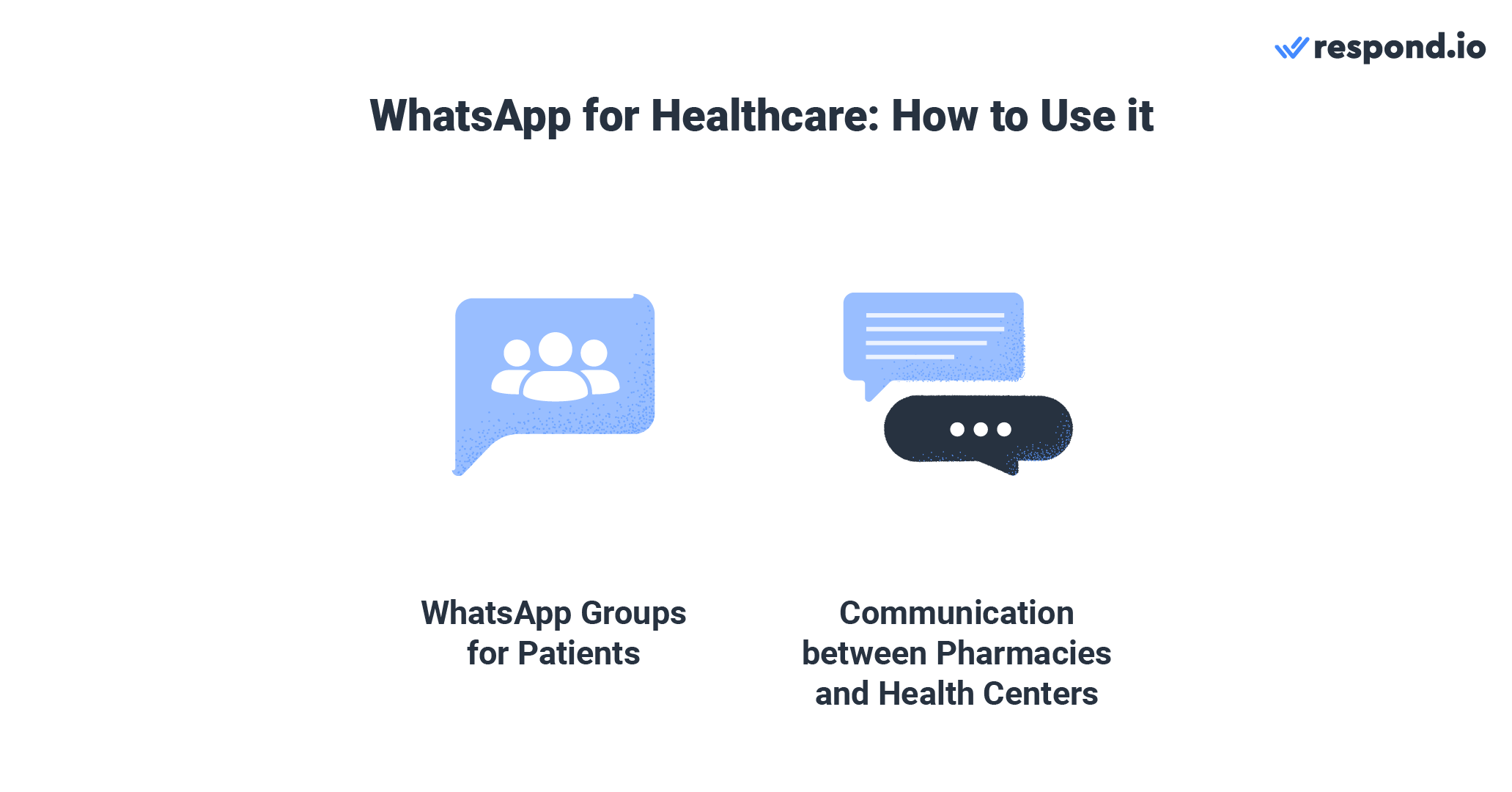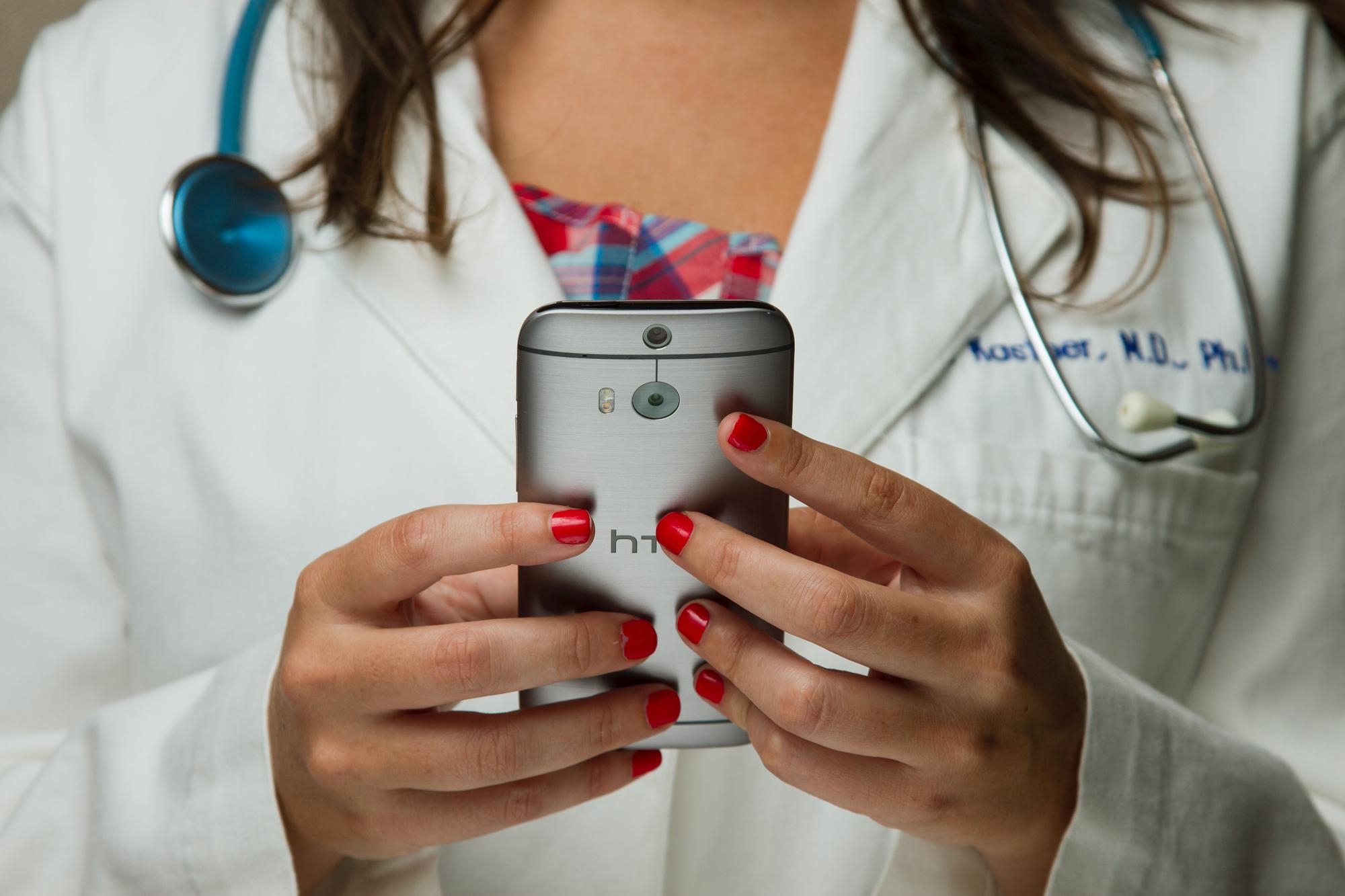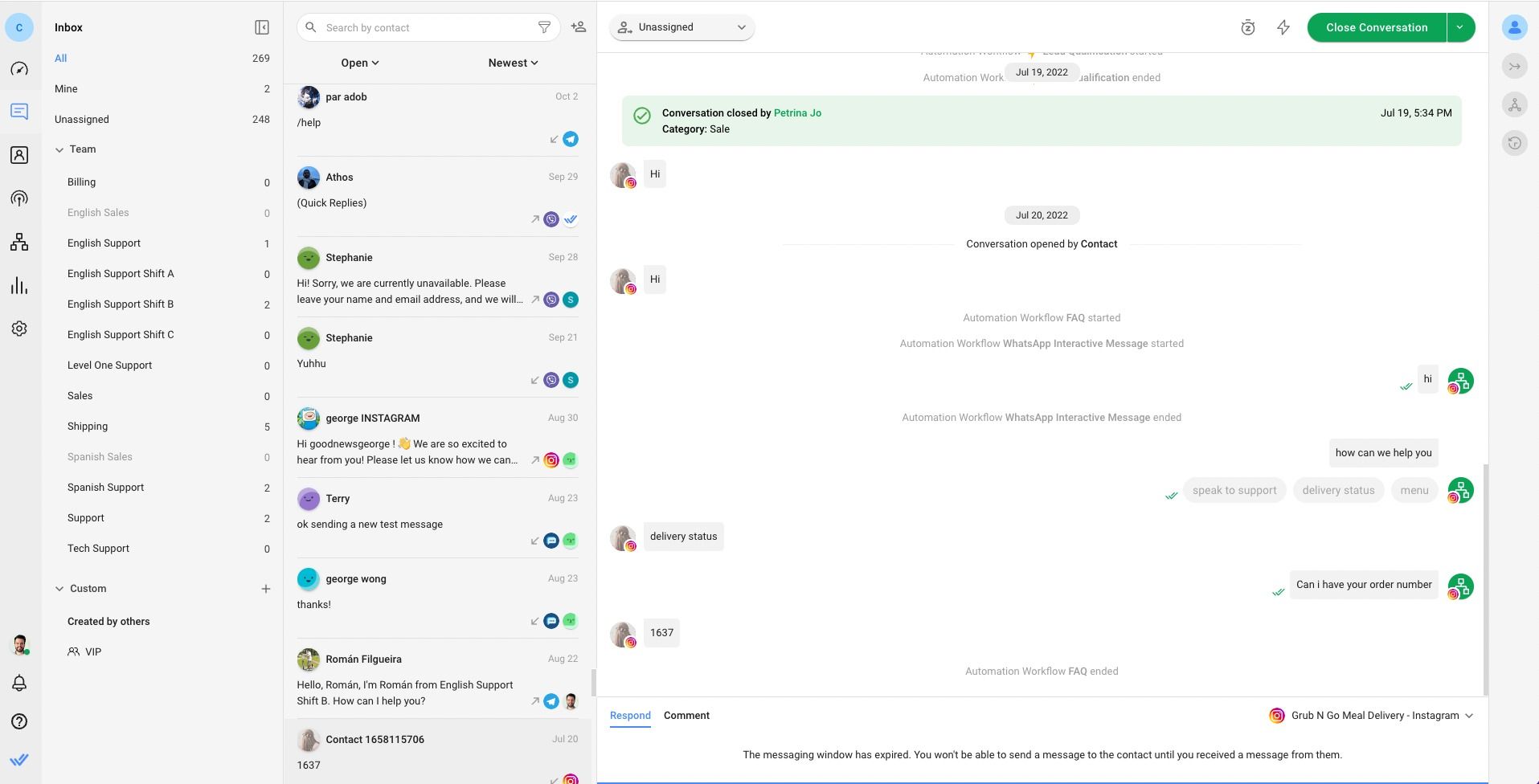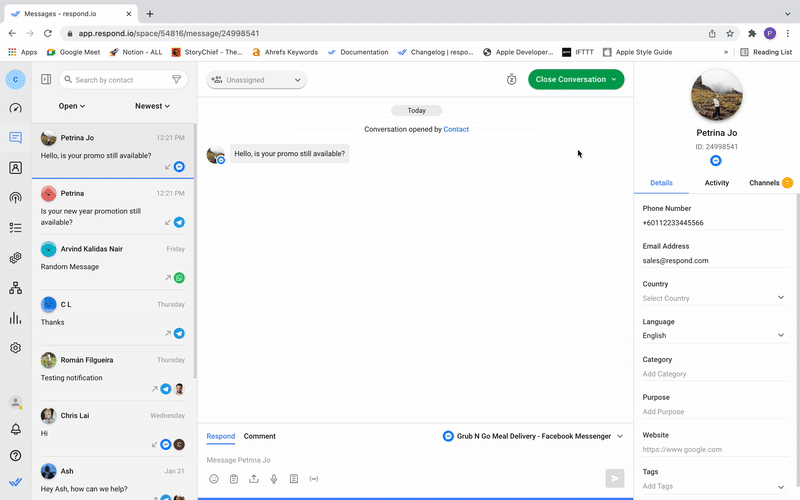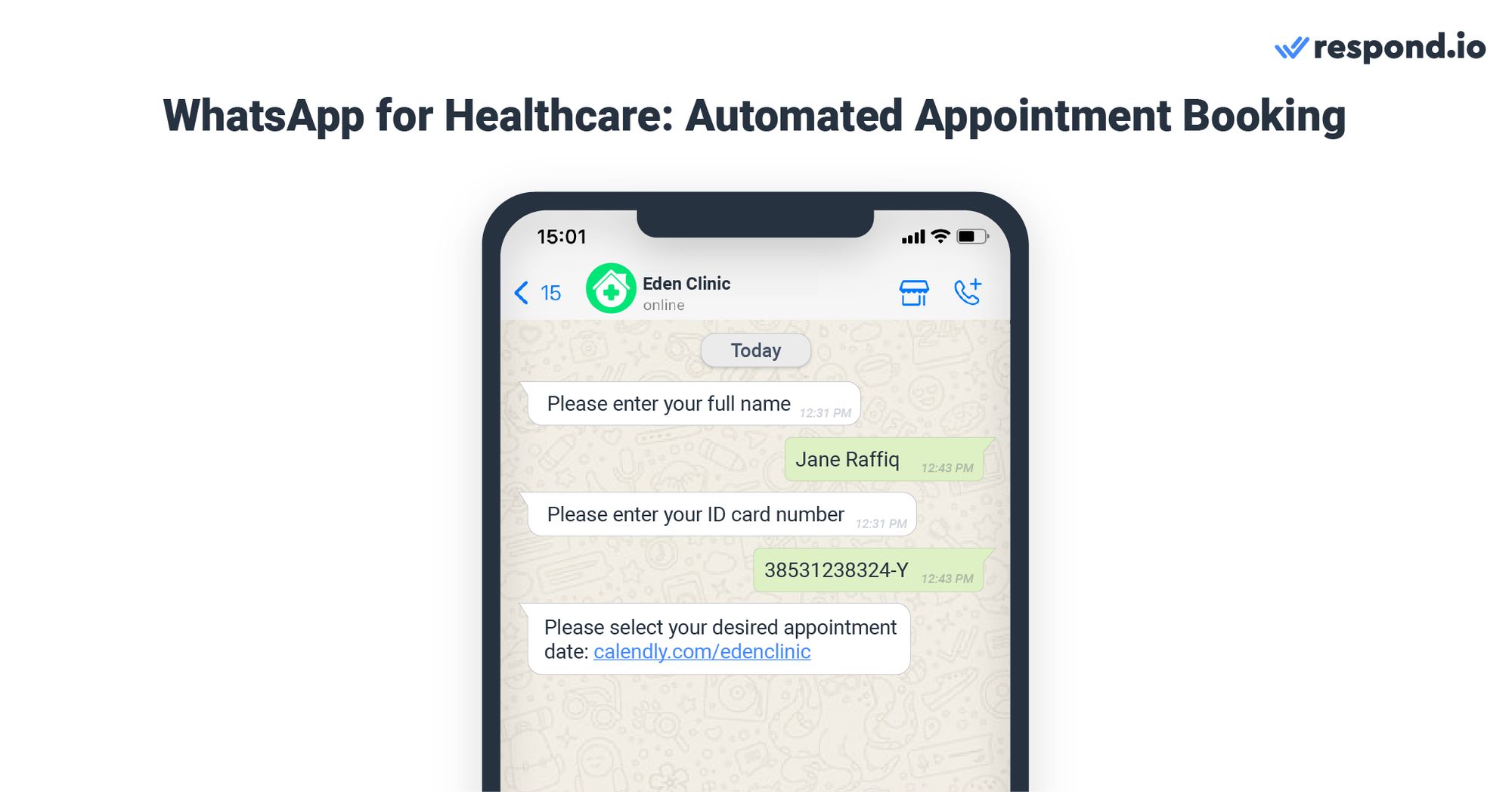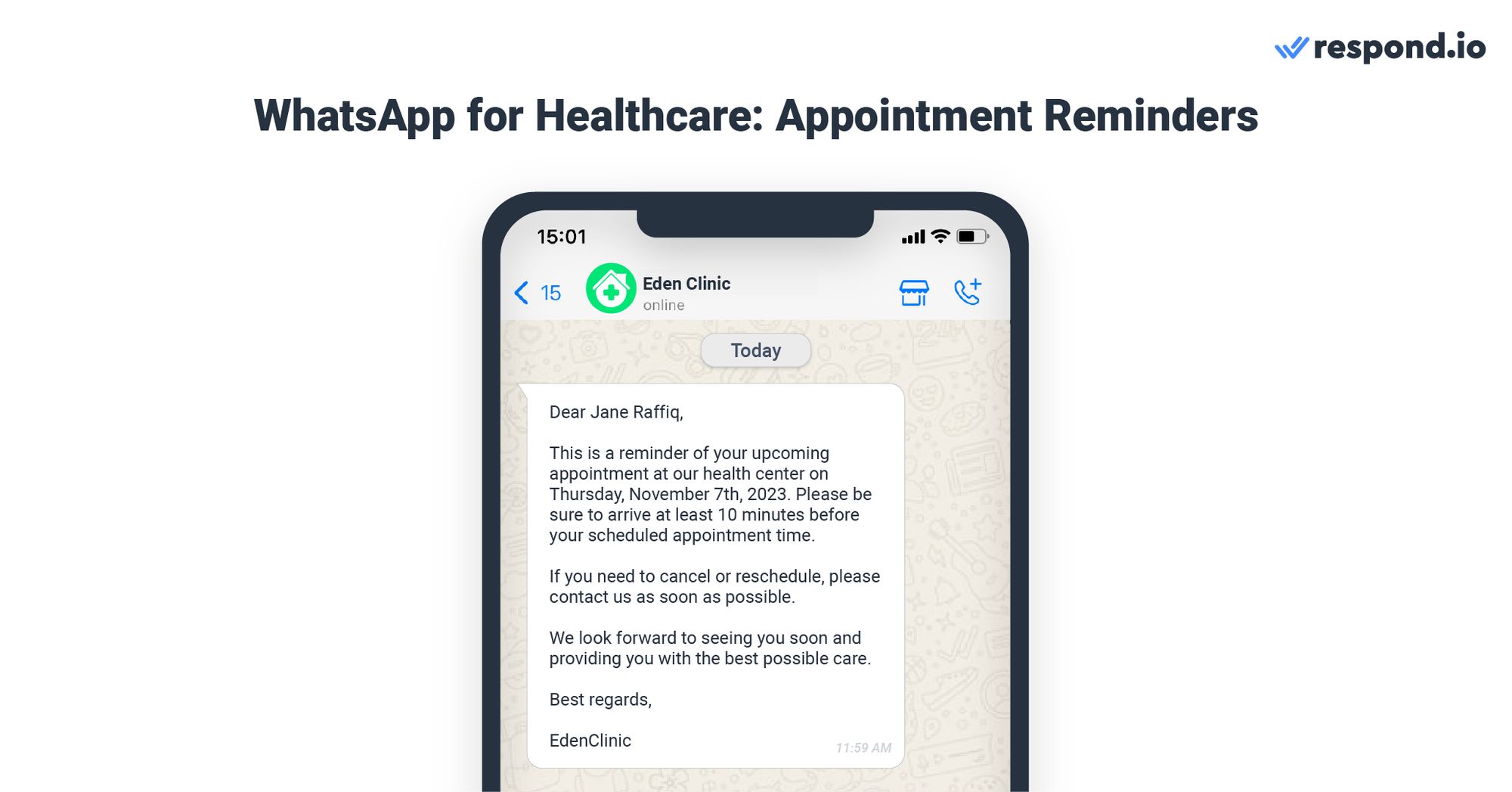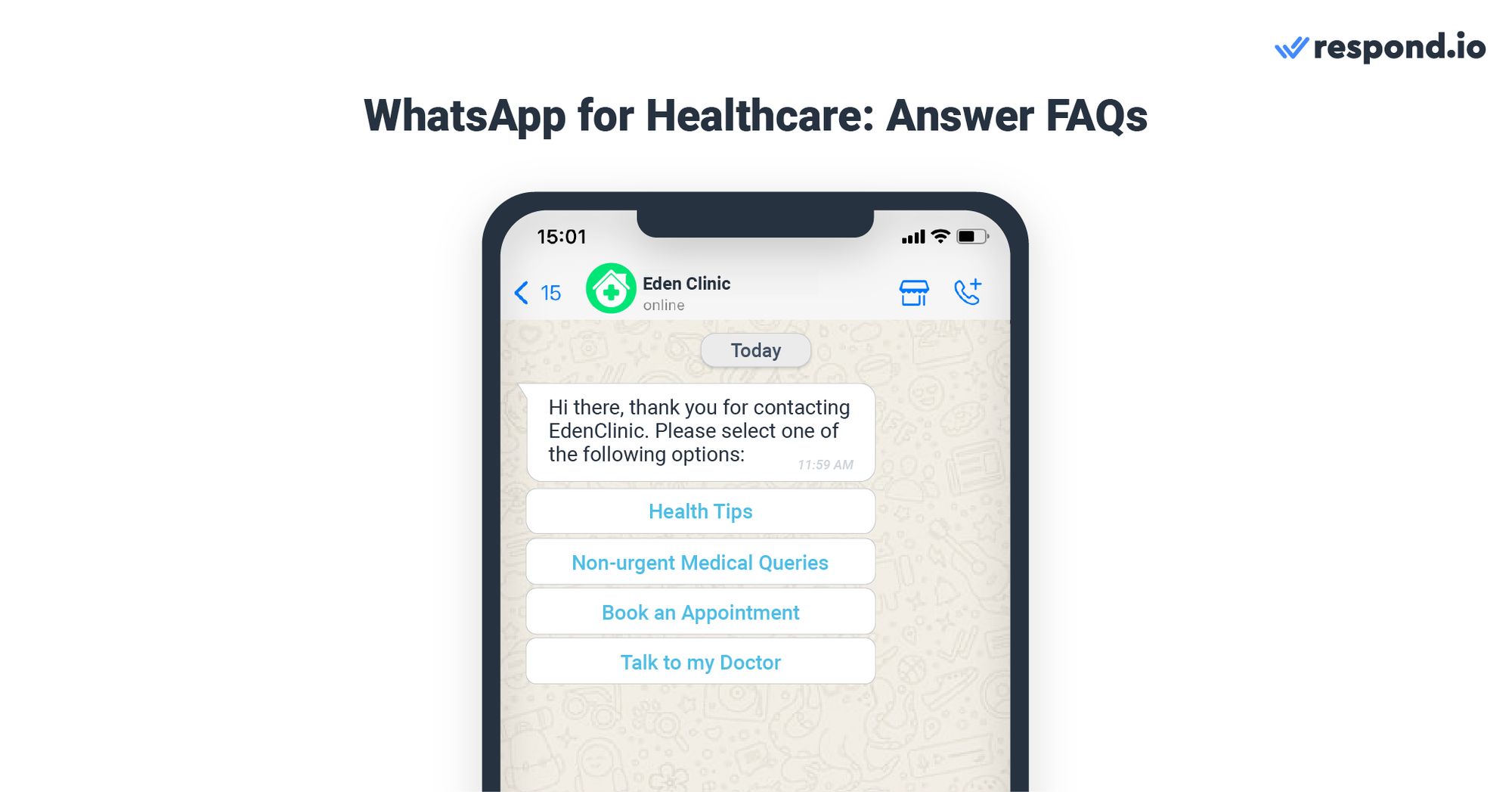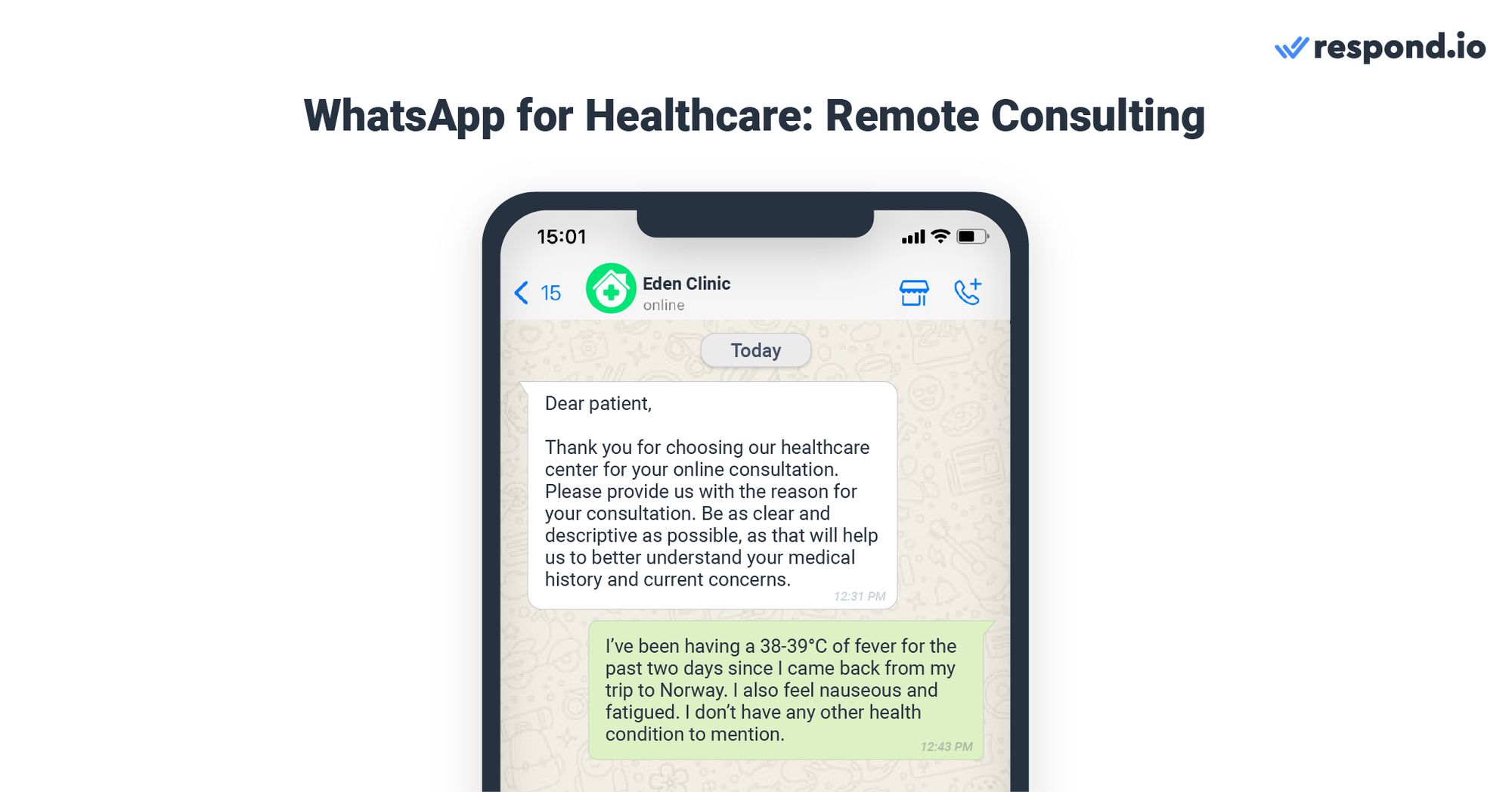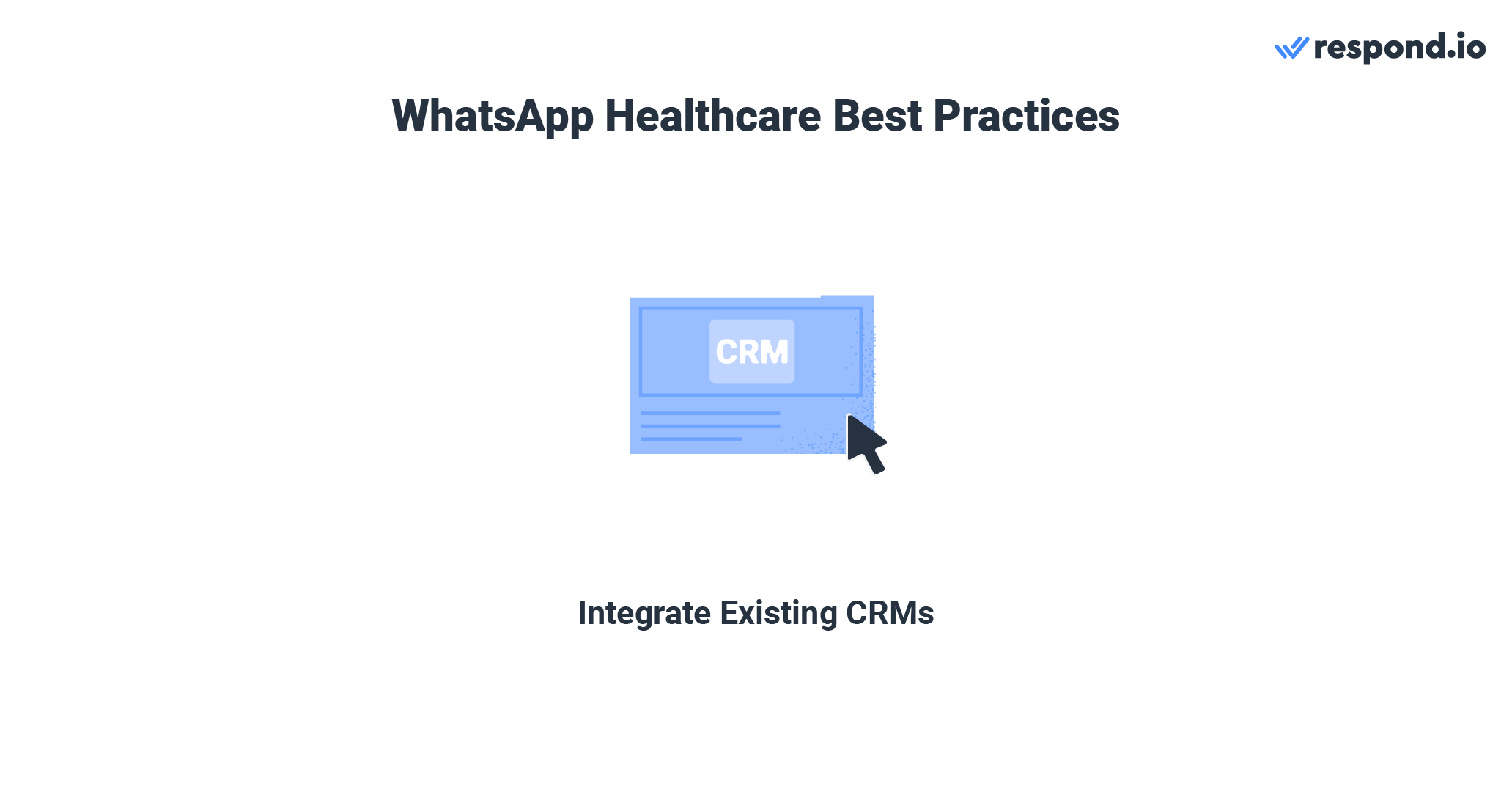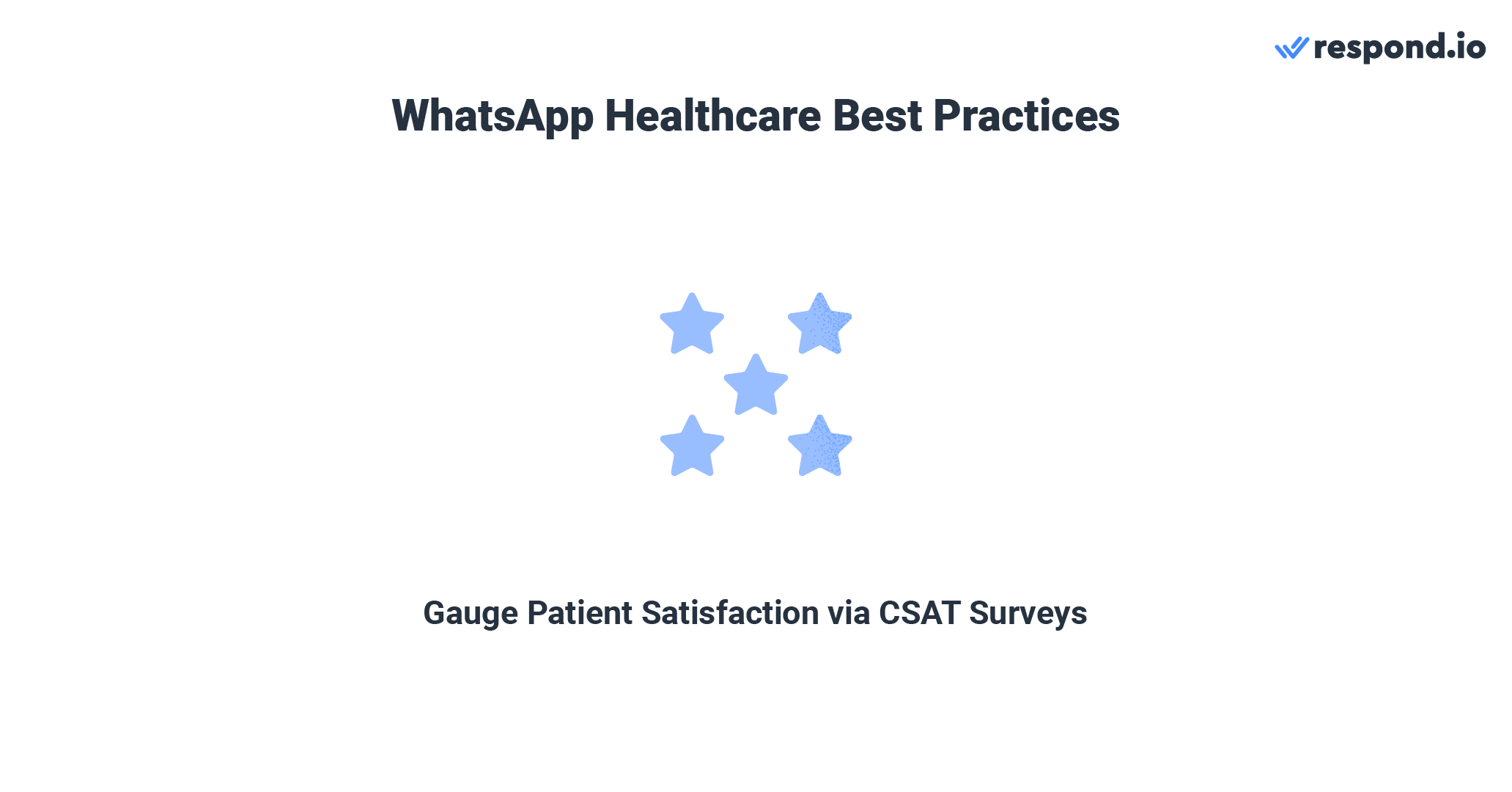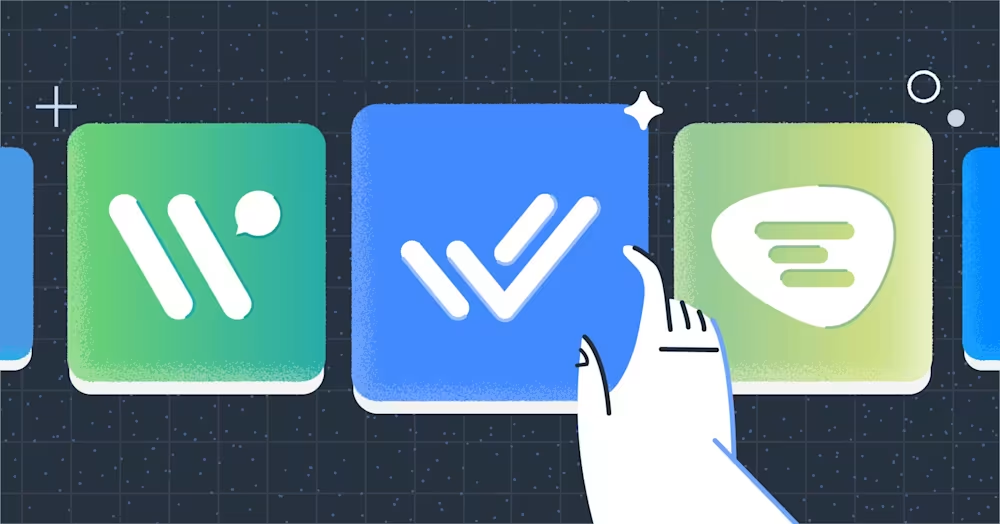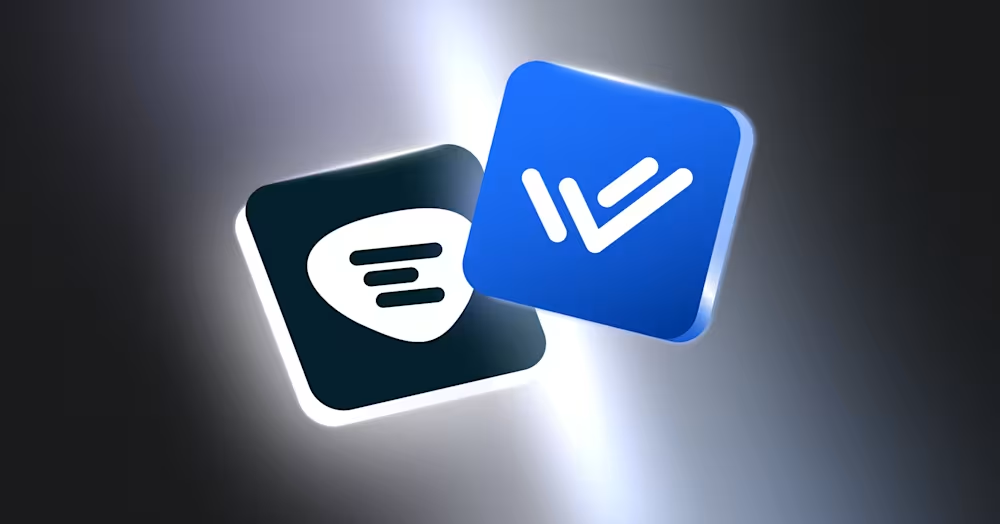Die COVID-19-Pandemie hat die Einführung von WhatsApp für die Gesundheitsversorgung in den Vordergrund gerückt. Viele Institutionen und Organisationen weltweit nutzen WhatsApp im Gesundheitswesen, um Dienstleistungen und Lösungen bereitzustellen, die die Betriebskosten minimieren und den Patienten schnelle, sichere und personalisierte Unterstützung bieten, auch in Krisenzeiten. In diesem Artikel werden wir alles besprechen, was du wissen musst, um mit WhatsApp für Gesundheitsversorgung loszulegen.
Was ist WhatsApp for Healthcare?
WhatsApp für die Gesundheitsversorgung bezieht sich auf die Verwendung von WhatsApp als Werkzeug zur Erleichterung der Kommunikation und Zusammenarbeit zwischen Gesundheitsdienstleistern, Patienten und andere Stakeholder der Gesundheitsbranche.
Mit der zunehmenden Verbreitung von Smartphones ist WhatsApp für über 2 Milliarden Menschen zum bevorzugten Kommunikationsmittel geworden.
Dies bietet Fachleuten im Gesundheitswesen die Möglichkeit, mit Patienten in einem Kanal zu kommunizieren, mit dem sie sich wohl fühlen. Lassen Sie uns die Gründe durchgehen, warum WhatsApp ein großartiger Nachrichtenkanal für die Gesundheitsbranche ist.
WhatsApp for Healthcare: Vorteile über traditionelle Messaging-Kanäle
WhatsApp ist allgegenwärtig geworden, und Menschen auf der ganzen Welt nutzen es um mit Freunden und Familie zu kommunizieren. Das bedeutet, dass Anbieter von Gesundheitsdiensten mit ihren Patienten über eine Plattform kommunizieren können, die ihnen bereits bekannt ist.
Egal wo eine Klinik oder ein Krankenhaus angesiedelt ist, es ist wahrscheinlich's, dass ihre Patienten WhatsApp bereits benutzen, Damit es zu einem zugänglichen und bequemen Instrument für die Kommunikation im Gesundheitswesen wird.
Ein weiterer wichtiger Vorteil bei der Verwendung von WhatsApp für die Kommunikation im Gesundheitswesen ist die Ende-zu-Ende-Verschlüsselung. Das bedeutet, dass Nachrichten, die über WhatsApp gesendet werden, nur für Absender und Empfänger sichtbar sind. Daher ist es eine sichere Plattform für den Austausch sensibler Daten wie medizinische Informationen.
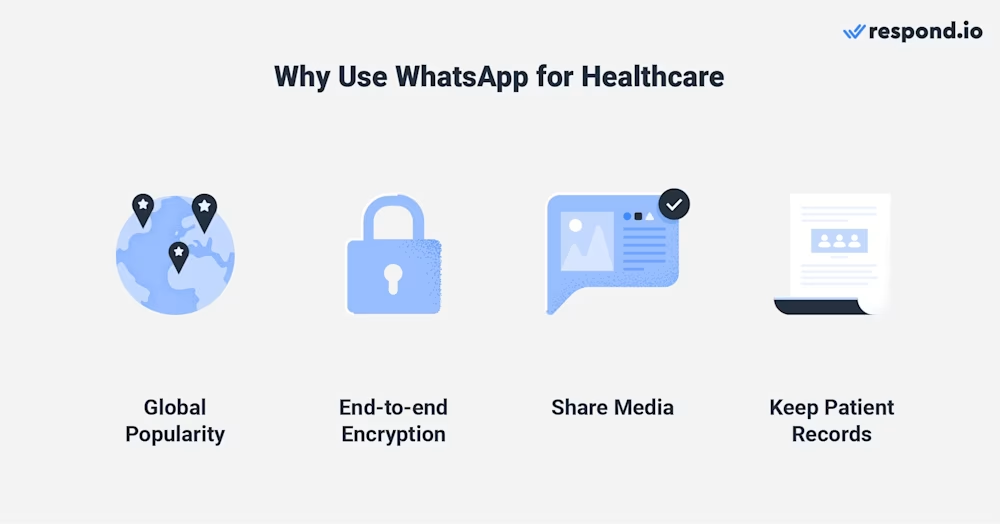
Die Ende-zu-Ende-Verschlüsselung stellt sicher, dass die Patientendaten vertraulich bleiben und vor unbefugtem Zugriff geschützt sind, was sowohl den Anbietern von Gesundheitsdiensten als auch den Patienten Sicherheit bietet.
Im Vergleich zu herkömmlichen Kommunikationskanälen wie Telefon und E-Mail bietet WhatsApp mehrere Vorteile für die Kommunikation im Gesundheitswesen. Zum Beispiel ermöglicht WhatsApp Anbietern das Senden von Dateien, Bildern, Videos und Sprachnotizen und erleichtert so die Kommunikation komplexer medizinischer Informationen.
Zusätzlich können die WhatsApp-Nachrichten jederzeit gespeichert, durchsucht und abgerufen werden, was einen Datensatz des Patienten's medizinischen Verlaufs liefert. Schließlich ermöglicht WhatsApp's Echtzeitkommunikation den Gesundheitsdienstleistern, schnell auf Patientenanfragen zu reagieren, die Wartezeiten zu reduzieren und die Patientenzufriedenheit zu verbessern.
WhatsApp for Healthcare: Geschäfts- und Handelsrichtlinien
Anbieter von Gesundheitsdiensten müssen die WhatsApp Geschäftsrichtlinien und Richtlinien sorgfältig überprüfen, um sicherzustellen, dass sie berechtigt sind, WhatsApp zu verwenden. Es ist wichtig, diese Regeln und Vorschriften zu befolgen, um Verstöße zu vermeiden, die zur Sperrung oder Kündigung des Kontos führen können.
Zuallererst sollten Sie die Zustimmung der Patienten' einholen, um WhatsApp Benachrichtigungen zu erhalten. Dies kann erfolgen, indem Sie die Patienten bitten, ihr Einverständnis zu geben, um Erinnerungen über WhatsApp zu erhalten, wenn sie ihre Termine planen.
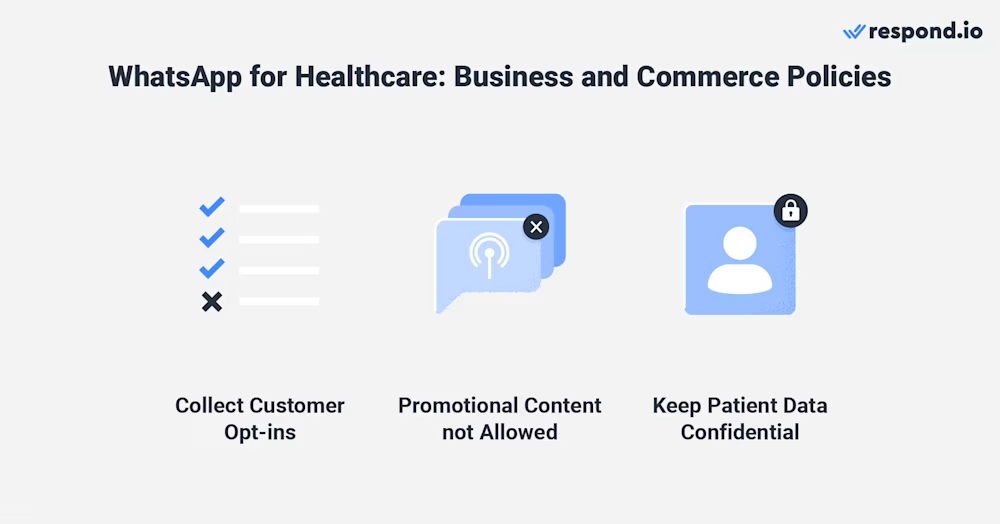
Darüber hinaus müssen die Anbieter von Gesundheitsdiensten sicherstellen, dass sie nur Informationen teilen, die für die Patientenversorgung notwendig und relevant sind, und dass die Informationen sicher durch Ende-zu-Ende-Verschlüsselung übertragen werden.
Patientendaten müssen gemäß den einschlägigen Gesetzen und Vorschriften geschützt und geheim gehalten werden. Darüber hinaus dürfen Gesundheitsanbieter WhatsApp nur für legitime Zwecke im Gesundheitswesen verwenden. und nicht für Marketing oder Werbeaktionen wie das Senden von Sendungen oder Massenmitteilungen.
Durch die Einhaltung dieser Richtlinien können Gesundheitsanbieter die sichere und sichere Übermittlung medizinischer Informationen über WhatsApp gewährleisten. Lassen Sie uns nun einige bewährte Verfahren durchgehen, die Unternehmen im Gesundheitswesen wissen sollten.
Verwandeln Sie Gespräche in Kunden mit der offiziellen WhatsApp-API von respond.io. ✨
Verwalten Sie WhatsApp-Anrufe und -Chats an einem Ort!
WhatsApp for Healthcare: Wie man sie verwendet
Gesundheitsunternehmen nutzen die WhatsApp Business App um WhatsApp Gruppenchats für Patienten zu erstellen Unterstützung von Gleichstellern, Informationsaustausch und Engagement in der Gemeinschaft.
Andere WhatsApp Gruppen können verwendet werden, um gesunde Lifestyle-Empfehlungen oder allgemeine Gesundheitsinformationen mit Patienten mit dem Ziel zu teilen, Wellness und Krankheitsvorbeugung zu fördern. Aber WhatsApp kann auch für die Kommunikation zwischen Gesundheitsunternehmen eingesetzt werden.
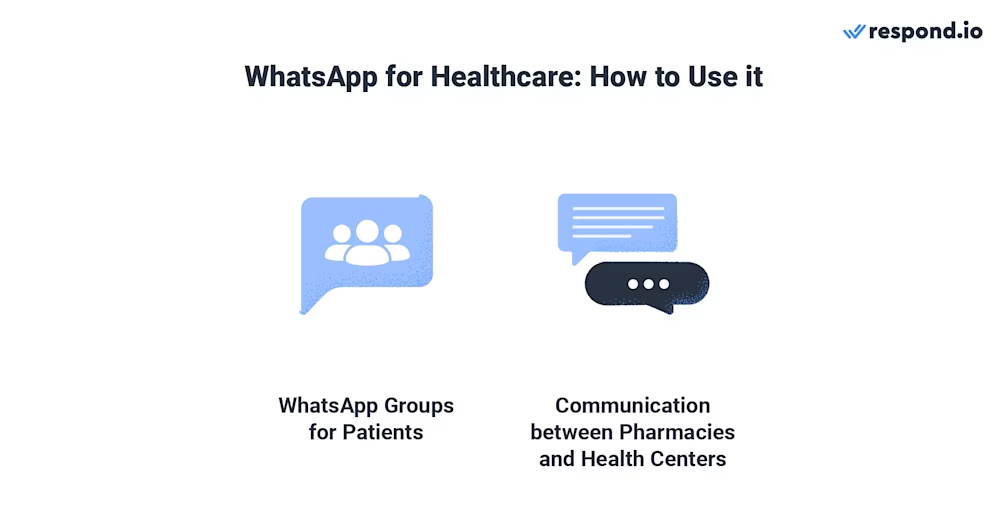
Medizinische Zentren können über WhatsApp verschreibungspflichtige Aufträge an Apotheken senden, einschließlich Patientendetails und verschreibungspflichtige Medikamente. Apotheker können die Bestellung bestätigen, sie liefern geschätzte Lieferzeiten und koordinieren Rezeptabholungen oder Lieferungen.
In ähnlicher Weise können Apotheken die medizinischen Zentren proaktiv über die Verfügbarkeit bestimmter Medikamente oder etwaiger Mangelerscheinungen informieren. Dies hilft medizinischen Zentren bei der Verschreibung von Medikamenten an Patienten.
Gesundheitsunternehmen weltweit setzen WhatsApp seit Jahren ein. Als nächstes diskutieren wir darüber, wie ein indisches Gesundheitsunternehmen WhatsApp Business für die Gesundheitsversorgung nutzt, um seine Operationen und die Patientenkommunikation zu verbessern.
Erfolgsgeschichte: Wie wird WhatsApp für Gesundheitswesen verwendet
Practo ist eines der führenden Unternehmen im Gesundheitswesen in Indien. Sie arbeitet als umfassende Gesundheitsplattform, die Patienten mit Ärzten, Kliniken, Diagnosezentren und anderen Gesundheitsdienstleistern verbindet.
Das Unternehmen bietet eine Reihe von Dienstleistungen an, darunter Online-Arztberatung, Terminplanung, Health Records Management und Wellness-Lösungen. Das Unternehmen hat WhatsApp in sein System integriert, um die Kommunikation zwischen Gesundheitsdienstleistern und Patienten zu verbessern.
Practo nutzt WhatsApp auf vielfältige Weise. Erstens buchen Patienten bequem Termine mit Ärzten und Gesundheitseinrichtungen über die Plattform Practo'über WhatsApp, vereinfacht den Prozess und stellt einen benutzerfreundlichen Kanal zur Verfügung.
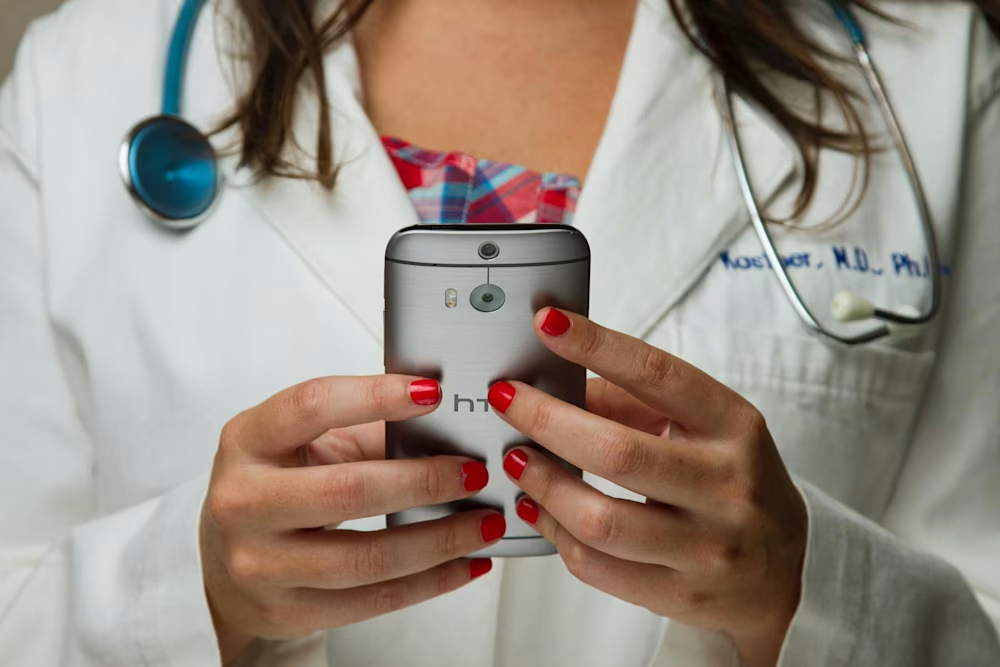
Zweitens verwendet die Praxis WhatsApp, um Termin-Erinnerungen zu versenden, um No-Shows zu reduzieren und die Termintreue zu verbessern. Patienten erhalten Erinnerungen per WhatsApp, informiert und auf Konsultationen vorbereitet.
Darüber hinaus ermöglicht WhatsApp eine sichere und direkte Kommunikation zwischen Ärzten und Patienten, so dass Patienten konsultieren und Fragen stellen können und bitten Sie um Klärung ihrer gesundheitlichen Bedenken, so dass die Notwendigkeit für persönliche Besuche für kleinere Anfragen vermieden wird.
Die Nutzung von WhatsApp durch Practo's verbessert die Patientenerfahrung durch die Optimierung der Terminbuchung, die Reduzierung von No-Shows durch Erinnerungen und die Bereitstellung eines sicheren und effizienten Kommunikationskanals für Arzt-Patienten-Interaktionen.
Wenn du die Geschichte von Practo entdeckt hast, lese weiter. Wir werden einige bewährte Methoden teilen, die du implementieren kannst, um mit Patienten auf WhatsApp zu kommunizieren.
WhatsApp for Healthcare: Best Practices mit Respond.io
Unternehmen nutzen die WhatsApp Business App oft um mit Kunden zu kommunizieren, da sie einfach und kostenlos sind. Es ist jedoch nur für Klein- und Kleinstunternehmen konzipiert, und es fehlen die erweiterten Funktionen und die Mehrbenutzerfähigkeiten für Gesundheitsunternehmen nötig.
WhatsApp API ist dagegen für große Unternehmen und Unternehmen konzipiert. Da es nur eine API ist, hat es kein Frontend, daher muss es mit einer Kundenkommunikations-Management-Software wie respond.io verbunden sein.
Mit der antworten. o WhatsApp Business API, Gesundheitsdienstleister können die Vorteile einer erweiterten Automatisierung nutzen Multi-Channel-Kommunikation und andere Funktionen, die es einfach machen, Patientengespräche zu verwalten und eine bessere Betreuung zu bieten. So können Sie über respond.io tolle Patientenerlebnisse auf WhatsApp erstellen.
WhatsApp Healthcare: Nachricht über jeden Kanal mit Omnichannel Posteingang
Der omnichannel Posteingang von respond.io ermöglicht es Gesundheitsdienstleistern, mit Patienten über mehrere Messaging-Apps zu kommunizieren, einschließlich WhatsApp, Facebook Messenger, LINE, Viber und viele andere, sodass Anbieter Patienten über die Messaging-App ihrer Wahl erreichen können, um das Engagement und die Zufriedenheit der Patienten zu verbessern.
Dieser Posteingang bietet für jeden Patienten eine umfassende Konsultationsgeschichte, die Gespräche über verschiedene Kanäle hinweg konsolidiert. Dies bedeutet, dass Anbieter schnell die vorherigen Nachrichten eines Patienten'für den Kontext überprüfen können.
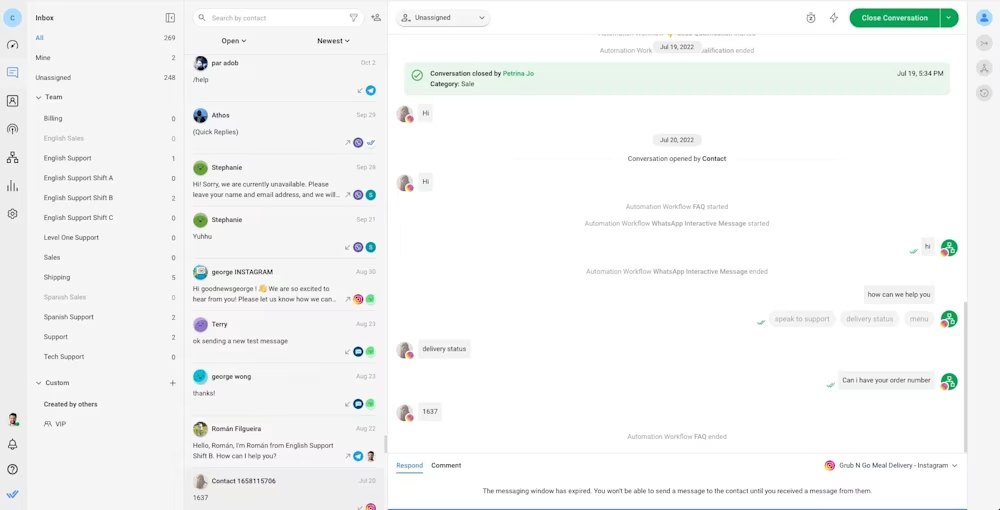
Dies schließt jegliche medizinische Geschichte oder andere relevante Informationen ein, bevor sie auf ihre aktuelle Nachricht antworten, sicherzustellen, dass Patienten eine individuell auf ihre spezifischen Bedürfnisse und Umstände zugeschnittene Betreuung erhalten.
Kontakte auf jedem Kanal korrekt identifizieren
Respond.io's Contact Merge Funktion ermöglicht das Zusammenführen von doppelten Kontaktinformationen zu einem einzigen Profil. Gesundheitsdienstleister nutzen die Kontaktzusammenführung, um Patientendaten und Gesprächsverlauf aus verschiedenen Kanälen zu konsolidieren.
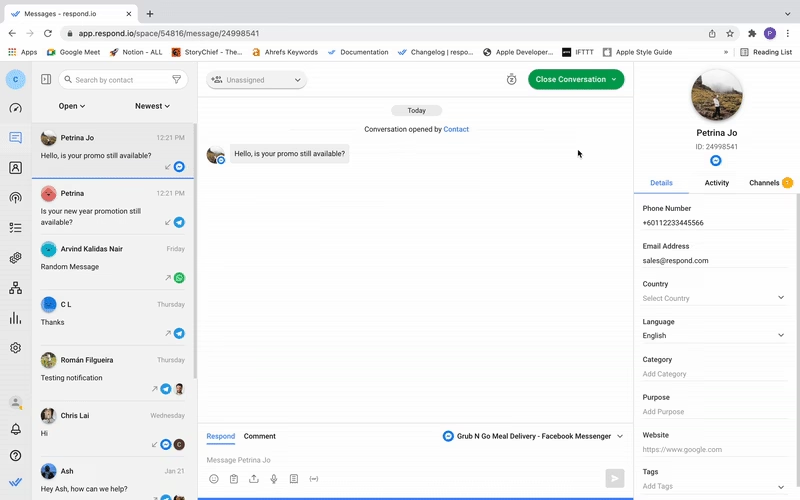
Dies kann die Kommunikation rationalisieren und das Risiko von Fehlern oder Verwirrung verringern, indem sichergestellt wird, dass alle relevanten Patienteninformationen an einem Ort zusammengehalten werden. Dadurch wird es Gesundheitsdienstleistern ermöglicht, ihren Patienten eine bessere, personalisierte Versorgung zu bieten.
WhatsApp Healthcare: Gemeinsame Prozesse automatisieren
Bei Verbindung mit respond.io macht WhatsApp API die Kommunikation zwischen Gesundheitsexperten und Patienten zeitsparend und effizient. Hier sind einige Wege, wie Sie das erreichen können.
WhatsApp Healthcare: Automatische Terminbuchung
Eine der HauptStärken des Respond.ios Workflow-Automatisierungsbauers ist die Automatisierung der Terminbuchung durch Chatautomatisierung. Sie können WhatsApp-Auto-Antwort oder geplante Nachrichten senden und Fragen stellen, um den Namen, die Kontaktdaten, den Zweck des Termins und die bevorzugte Terminzeit des Patienten mit einem Workflow zu sammeln.
Eine der effektivsten Methoden, um medizinische Termine zu verwalten, sind Kalender-Tools wie Google Kalender oder Calendly. Sie können diese mit der WhatsApp API via respond.io integrieren, so dass sie während der Chats abgerufen werden können.
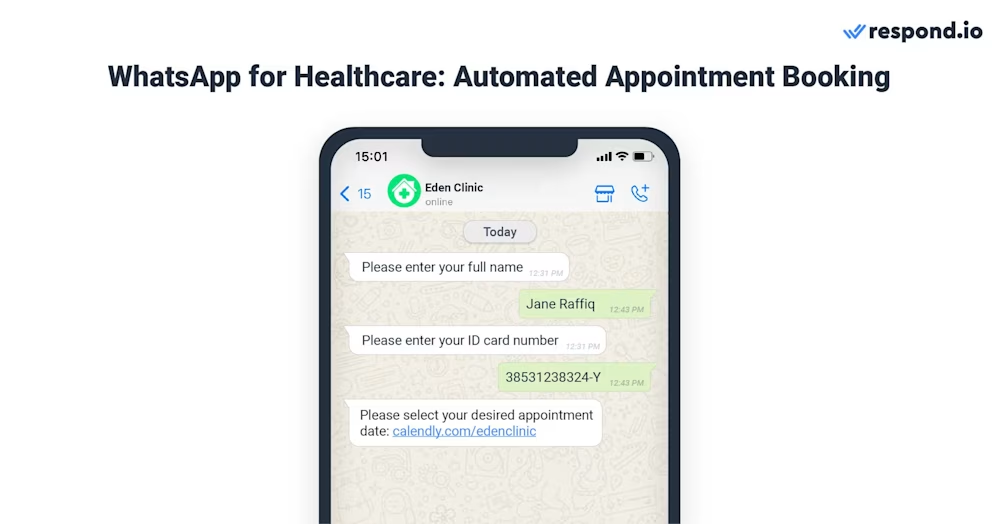
Sobald der Patient seine bevorzugte Terminzeit im Chat eingegeben hat, richten Sie ein automatisiertes System ein, um die verfügbaren Termine zu überprüfen und den Termin gemäß den Präferenzen des Patienten zu planen.
WhatsApp Healthcare: Erinnerungen für Arzttermine senden
Mit Zapier können Sie einen Zap erstellen, der Erinnerungen an Patienten auf WhatsApp über respond.io eine bestimmte Anzahl von Stunden oder Tagen vor dem geplanten Termin sendet. Passen Sie die Nachricht an, um Details wie Datum, Uhrzeit und Ort des Termins einzufügen.
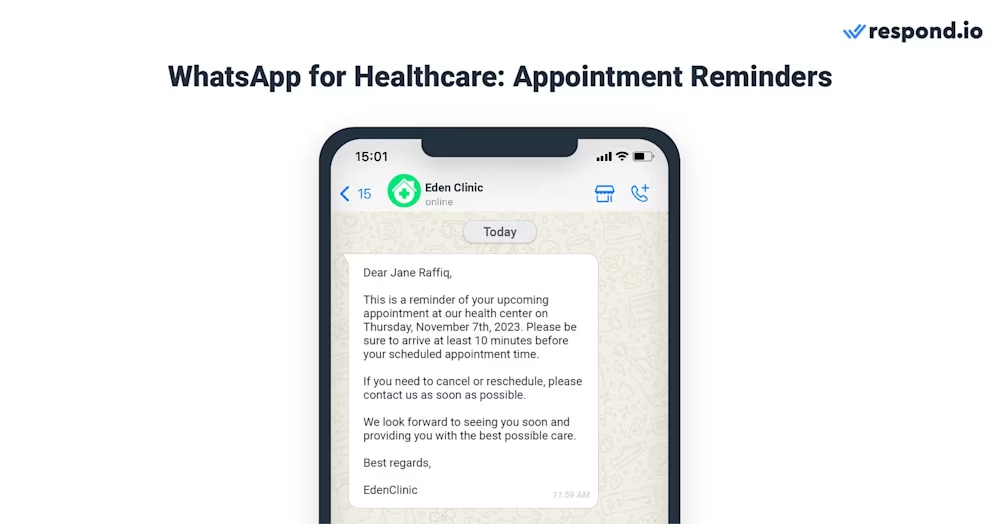
Legen Sie die Häufigkeit der Erinnerung fest. Diese werden in der Regel ein paar Tage vor dem Termin verschickt, sowie einige Stunden vor dem Termin. Ähnlich wie bei einer WhatsApp-Drip-Kampagne verwenden Sie das Workflow-Modul, um eine Nachrichtensequenz über einen bestimmten Zeitraum einzurichten.
WhatsApp Healthcare: Antworten Sie Fragen mit einem FAQ Menü
Einer der Vorteile eines WhatsApp FAQ Menüs ist, dass es Patienten schnellen und einfachen Zugang zu Informationen geben kann. So können Patienten auf die benötigten Informationen zugreifen, ohne warten zu müssen oder das Büro des Anbieters besuchen zu müssen.
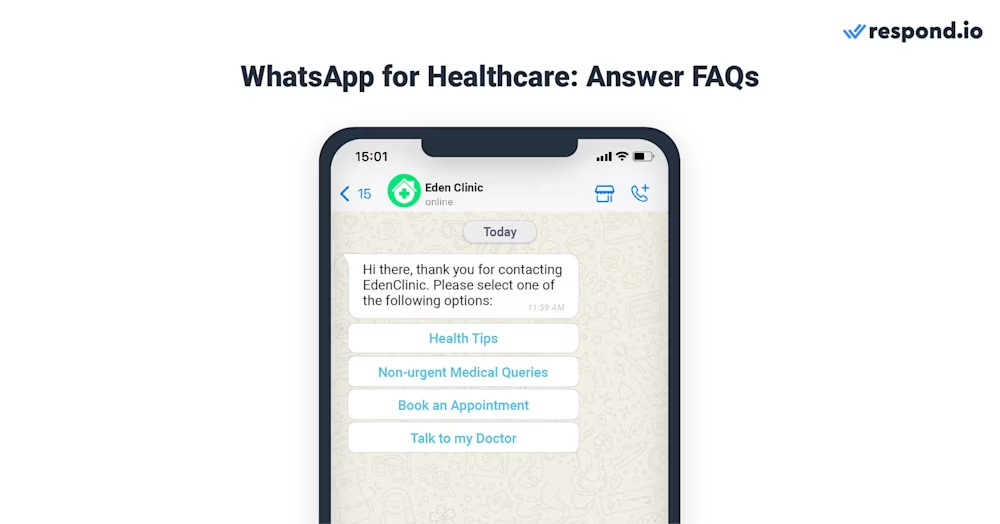
Ein Anbieter von Gesundheitsdienstleistungen könnte ein FAQ-Menü mit Optionen wie „Gesundheitstipps“, „Häufig gestellte Fragen“, „Nicht dringende medizinische Anfragen“ und „Terminbuchung“ einrichten. Wenn ein Patient eine Nachricht an die WhatsApp-Nummer des Anbieters sendet, erhält er eine automatisierte Antwort mit den Menüoptionen.
WhatsApp Healthcare: Bieten Sie Remote Consulting mit offenen Fragen an
Offene Fragen sind Fragen, die es Patienten ermöglichen, qualitative Informationen in ihren eigenen Worten zu liefern. Gesundheitsdienstleister können Workflows verwenden, um offene Fragen einzurichten und Informationen über die' Symptome der Patienten zu sammeln.
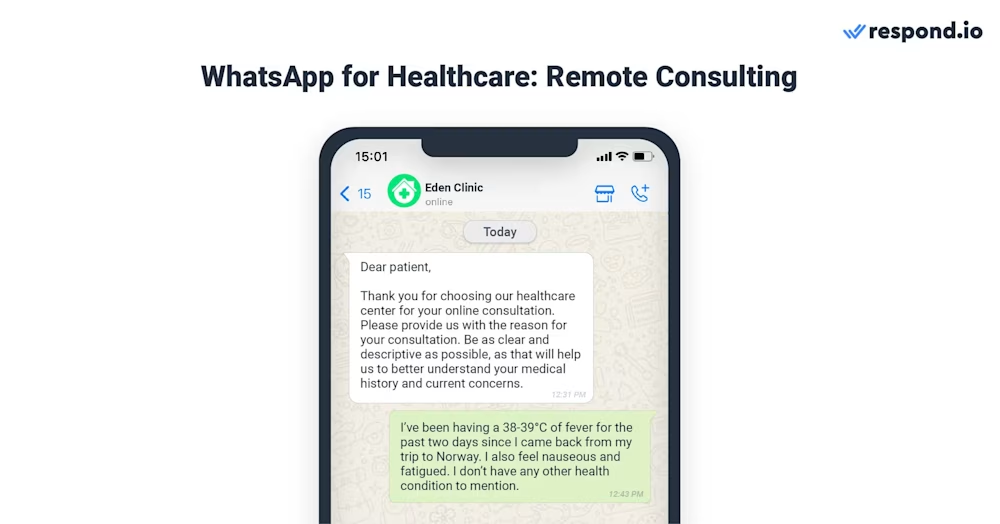
Basierend auf den durch den Workflow erfassten Informationen können Patienten automatisch dem entsprechenden E-Health-Spezialisten zugewiesen werden. Während dieses System zur Klärung milder Fälle gültig ist, sollte es nur verwendet werden, um vor Konsultationen Informationen für komplexere Fälle zu sammeln, damit die Fakten zu Beginn vorliegen.
Existierende CRMs integrieren
Integration Ihrer CRMs auf Respond.io ermöglicht Ihnen die Zentralisierung von Patientendaten, die Reduzierung von Fehlern und die Verbesserung der Zusammenarbeit zwischen Gesundheitsexperten. Es ermöglicht einen einfachen Zugang zu Patientenprofilen und ihrer medizinischen Geschichte sowie den Austausch relevanter Informationen mit Teams zur Verbesserung der Qualität der geleisteten Betreuung.
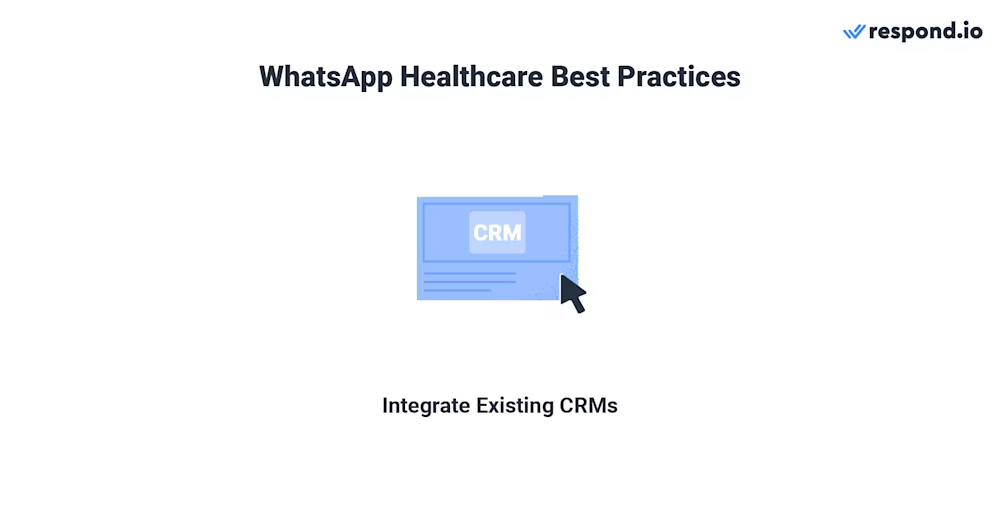
Diese Integration eröffnet den Gesundheitsunternehmen viele neue Möglichkeiten. Zum Beispiel kann es verwendet werden, um Daten aus Ihrem CRM bequem abzurufen, um Kontaktfelder auf respond.io zu aktualisieren.
Patientenzufriedenheit über CSAT-Umfragen
CSAT-Umfragen können wertvolle Einblicke in die Patientenzufriedenheit und die verbesserungsfähigen Bereiche geben. Durch die Analyse der aus diesen Umfragen erfassten Daten können Gesundheitsanbieter Trends erkennen, Stärken und Schwächen sowie datenbezogene Entscheidungen zur Verbesserung der Patientenerfahrung zu treffen.
Am wichtigsten ist, dass CSAT-Umfragen den Patienten beweisen, dass ihre Meinungen und ihr Feedback geschätzt werden. Dies kann zu erhöhter Patientenzufriedenheit und Loyalität mit der Zeit führen.
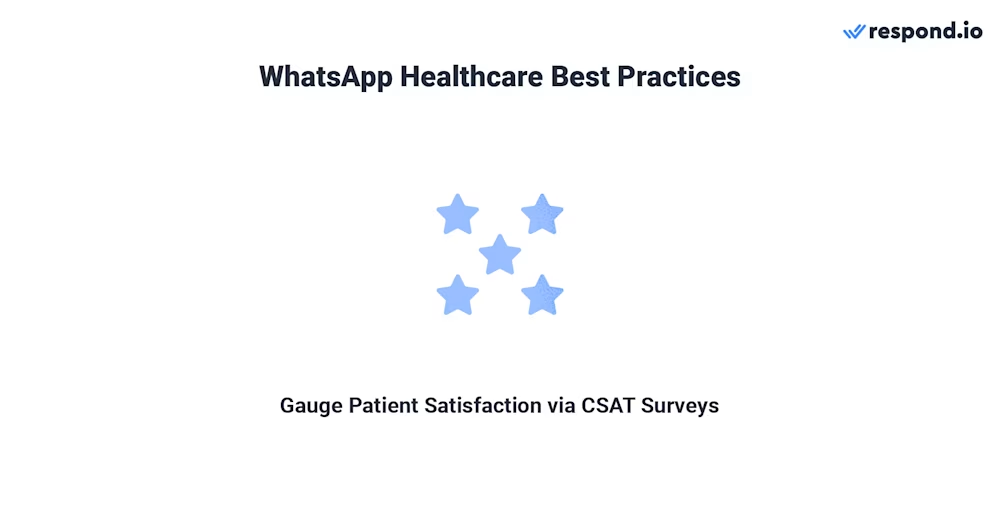
Sie können die Kundenzufriedenheit durch Integration Ihrer Umfragesoftware mit respond.io messen. Erstellen Sie einen CSAT Workflow von Grund auf oder verwenden Sie eine CSAT Vorlage um schnell loszulegen. Sie können die Antworten in Google Sheets oder in Ihrem Datenlager speichern.
Abschließend möchte ich sagen, dass Anbieter von Gesundheitsdiensten die Integration von WhatsApp API als Patientenkommunikationskanal in Betracht ziehen sollten. Durch den Anschluss an respond.io erhalten sie Zugang zu fortgeschrittener Automatisierung und anderen wertvollen Funktionen für die gesamte Patientenreise. Um zu beginnen, melden Sie sich für eine kostenlose Testversion von respond.io an oder verbinden Sie jetzt die WhatsApp API.
Verwandeln Sie Gespräche in Kunden mit der offiziellen WhatsApp-API von respond.io. ✨
Verwalten Sie WhatsApp-Anrufe und -Chats an einem Ort!
Weiterführende Hinweise.
Wenn du diesen Artikel interessant fandest, findest du hier einige weitere Lesungen, die dir gefallen könnten:
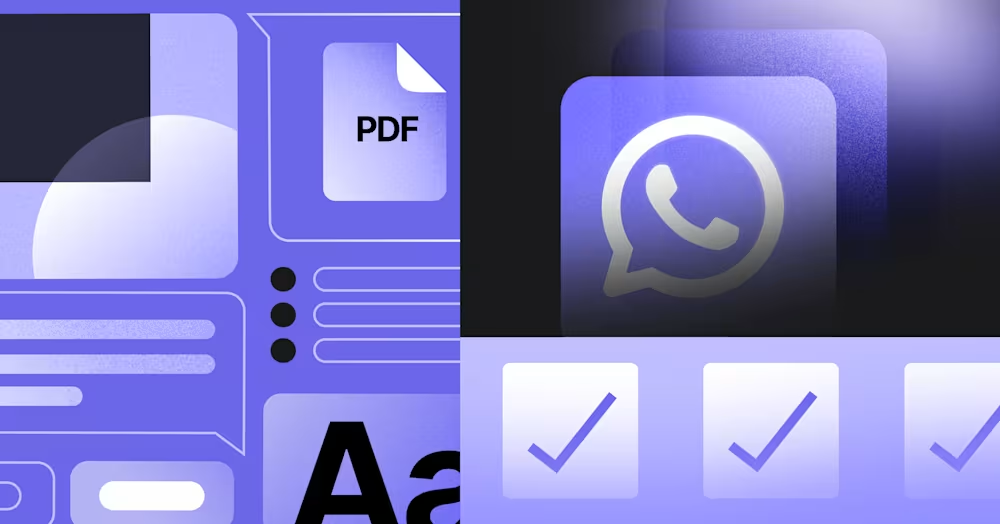



































 Übersicht
Übersicht Elektronisch
Elektronisch Mode & Kleidung
Mode & Kleidung Möbel
Möbel Schmuck
Schmuck
 Außerschulische Aktivitäten
Außerschulische Aktivitäten Sport & Fitness
Sport & Fitness
 Schönheitszentrum
Schönheitszentrum Zahnklinik
Zahnklinik Medizinische Klinik
Medizinische Klinik
 Reinigungs- und Haushaltshilfen
Reinigungs- und Haushaltshilfen Fotografie & Videografie
Fotografie & Videografie
 Autoteile Einzelhändler
Autoteile Einzelhändler Autohändler
Autohändler
 Reisebüro & Reiseveranstalter
Reisebüro & Reiseveranstalter

![WhatsApp for Healthcare: Ein umfassender Leitfaden [Juli 2023]](https://assets2-proxy.respond.io/ph8r57dk1q9w/2Yq92bZ18m4K0xdnrFKllK/382e15337e521d2f890295fe242bda63/concepts-whatsapp-for-healthcare-cover_c9df6d4d728679fbb00b47c25f1c6904.jpg?q=70&fm=avif)
